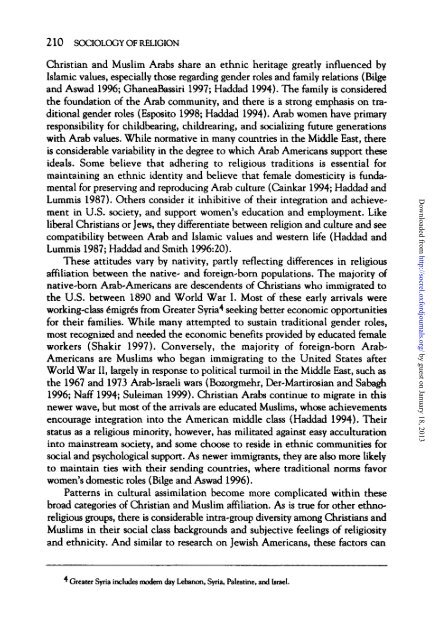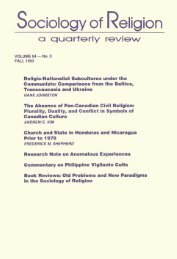The Sources of Gender Role Attitudes among Christian and Muslim ...
The Sources of Gender Role Attitudes among Christian and Muslim ...
The Sources of Gender Role Attitudes among Christian and Muslim ...
You also want an ePaper? Increase the reach of your titles
YUMPU automatically turns print PDFs into web optimized ePapers that Google loves.
210 SOCIOLOGY OF RELIGION<br />
<strong>Christian</strong> <strong>and</strong> <strong>Muslim</strong> Arabs share an ethnic heritage greatly influenced by<br />
Islamic values, especially those regarding gender roles <strong>and</strong> family relations (Bilge<br />
<strong>and</strong> Aswad 1996; GhaneaBassiri 1997; Haddad 1994). <strong>The</strong> family is considered<br />
the foundation <strong>of</strong> the Amb community, <strong>and</strong> there is a strong emphasis on tra-<br />
ditional gender roles (Esposito 1998; Haddad 1994). Amb women have primary<br />
responsibility for childbearing, childrearing, <strong>and</strong> socializing future generations<br />
with Amb values. While normative in many countries in the Middle East, there<br />
is considerable variability in the degree to which Arab Americans support these<br />
ideals. Some believe that adhering to religious traditions is essential for<br />
maintaining an ethnic identity <strong>and</strong> believe that female domesticity is funda-<br />
mental for preserving <strong>and</strong> reproducing Arab culture (Cainkar 1994; Haddad <strong>and</strong><br />
Lummis 1987). Others consider it inhibitive <strong>of</strong> their integration <strong>and</strong> achieve-<br />
ment in U.S. society, <strong>and</strong> support women's education <strong>and</strong> employment. Like<br />
liberal <strong>Christian</strong>s or Jews, they differentiate between religion <strong>and</strong> culture <strong>and</strong> see<br />
compatibility between Arab <strong>and</strong> Islamic values <strong>and</strong> western life (Haddad <strong>and</strong><br />
Lummis 1987; Haddad <strong>and</strong> Smith 1996:20).<br />
<strong>The</strong>se attitudes vary by nativity, partly reflecting differences in religious<br />
affiliation between the native- <strong>and</strong> foreign-born populations. <strong>The</strong> majority <strong>of</strong><br />
native-born Arab-Americans are descendents <strong>of</strong> <strong>Christian</strong>s who immigrated to<br />
the U.S. between 1890 <strong>and</strong> World War I. Most <strong>of</strong> these early arrivals were<br />
working-class ›233 from Greater Syria4 seeking better economic opportunities<br />
for their families. While many attempted to sustain traditional gender roles,<br />
most recognized <strong>and</strong> needed the economic benefits provided by educated female<br />
workers (Shakir 1997). Conversely, the majority <strong>of</strong> foreign-born Arab-<br />
Americans ate <strong>Muslim</strong>s who began immigrating to the United States after<br />
World War II, largely in response to political turmoil in the Middle East, such as<br />
the 1967 <strong>and</strong> 1973 Arab-Israeli wars (Bozorgmehr, Der-Martirosian <strong>and</strong> Sabagh<br />
1996; Naff 1994; Suleiman 1999). <strong>Christian</strong> Arabs continue to migrate in this<br />
newer wave, but most <strong>of</strong> the arrivals are educated <strong>Muslim</strong>s, whose achievements<br />
encourage integration into the American middle class (Haddad 1994). <strong>The</strong>ir<br />
status asa religious minority, however, has militated against easy acculturation<br />
into mainstream society, <strong>and</strong> some choose to reside in ethnic communities for<br />
social <strong>and</strong> psychological support. As newer immigrants, they are also more likely<br />
to maintain ties with their sending countries, where traditional norms favor<br />
women's domestic roles (Bilge <strong>and</strong> Aswad 1996).<br />
Patterns in cultural assimilation become more complicated within these<br />
broad categories <strong>of</strong> <strong>Christian</strong> <strong>and</strong> <strong>Muslim</strong> affiliation. As is true for other ethno-<br />
religious groups, there is considerable intra-group diversity <strong>among</strong> <strong>Christian</strong>s <strong>and</strong><br />
<strong>Muslim</strong>s in their social class backgrounds <strong>and</strong> subjective feelings <strong>of</strong> religiosity<br />
<strong>and</strong> ethnicity. And similar to research on Jewish Americans, these factors can<br />
4 Greater S~ria includes modero dau Lebanon, S~ia, Palestine, <strong>and</strong> Israel.<br />
Downloaded from<br />
http://socrel.oxfordjournals.org/<br />
by guest on January 18, 2013



